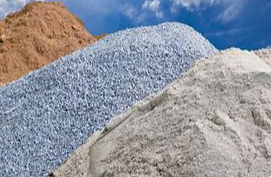Due to its strength and adaptability, concrete is the most often used building material in the world and serves as the foundation for many projects. A key component that is essential to the success of concrete is aggregates. When appropriately chosen and metered, these tiny, granular ingredients are essential to the strength, longevity, and workability of concrete. This blog post will discuss the importance of aggregates in concrete and the things to think about when selecting the best mix for your building requirements.

Comprehending Concrete Aggregates
In essence,aggregates are the granular, inert components that are combined with water and cement to create concrete. They provide concrete its mechanical and aesthetic qualities and make up a large amount of its volume. In concrete, aggregates come in two main varieties:
Aggregates: The largest particles in the mixture, aggregates give concrete its bulk and include sand, gravel, and crushed stone. The strength and durability of the concrete are affected by the adhesion between cement particles and aggregates, which is influenced by the surface properties of the aggregates at the nanoscale
- Coarse Mixtures:
These are bigger particles, often measuring between 3/8 and 1.5 inches. Crushed stone and gravel are typical varieties. The majority of concrete’s volume and strength come from coarse particles.
- Coarse Particles:
Fine aggregates are made up of smaller particles that are usually no bigger than 3/8 inch. These particles are frequently crushed stone dust or sand. They help to create a dense and workable concrete mix by filling the voids left by the coarse particles.
The Function of Concrete Aggregates
In concrete, aggregates are not only filler; they are essential to the material’s overall functionality. Among the crucial roles they play are the following:
- Sturdiness and Weight-Bearing Ability:
Concrete’s primary structural component is made of coarse particles. Because of the strong matrix that their interlocking particles produce, concrete has the compressive strength to support large loads.
- Practicality:
Concrete’s workability and flow can be managed with the use of fine aggregates. Maintaining structural integrity while making the mix easy to put, polish, and shape is ensured by the proper percentage of fine aggregates.
- Sturdiness:
The concrete’s ability to withstand wear, freeze-thaw cycles, and chemical exposure can be greatly impacted by the aggregate selection. The long-term durability of concrete can be improved with properly graded aggregates that have the right mineral makeup.
- Visual Appeal:
Concrete’s appearance is also influenced by aggregates. For instance, exposed aggregate concrete can be utilized to create beautiful surfaces and highlights the beauty of the aggregate particles.
Selecting Appropriate Aggregates
Choosing the proper aggregates for a concrete mix is an important choice that is influenced by a number of variables:
- Necessary Structure:
Think about the particular requirements your project has. For structures that support a lot of weight, including bridges and dams, durable, superior coarse aggregates are required. Fine aggregates with an appealing appearance are necessary for decorative applications.
- Equivalency
A properly graded particle size distribution of the aggregates is necessary to provide adequate compaction and reduce voids in the concrete mix. This enhances robustness and longevity.
- Sturdiness:
Aggregates ought to be devoid of contaminants such as silt, clay, and organic materials. Potential problems like poor adhesion and decreased durability are avoided by using clean aggregates.
- Particular Features:
Take into account any special qualities needed for your project. For instance, aggregates with a high resistance to chloride penetration may be required in coastal regions due to saltwater exposure.
- Ecological Viability:
The use of recycled aggregates or substitute materials, including lightweight aggregates, is growing in popularity for sustainable construction methods as environmental concerns rise.
- In summary
The unsung heroes of the concrete world, aggregates provide our constructions the strength and longevity they need to function. Selecting the ideal aggregate mix is a craft that calls for thorough evaluation of the project’s unique needs, environmental considerations, and sustainability objectives. Achieving the proper performance and beauty for any construction project requires an awareness of the role that aggregates play in concrete, regardless of whether you’re working on a tall skyscraper or a charming patio.

Pingback: Microscopic World of Concrete: Understanding the Nanostructure - Civil and Building